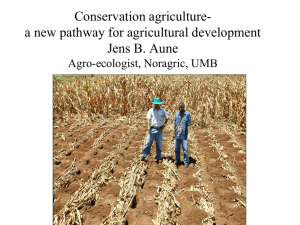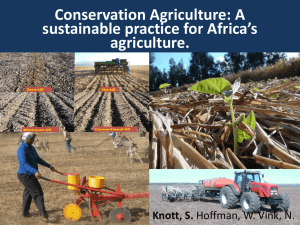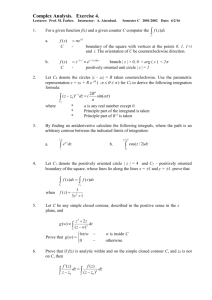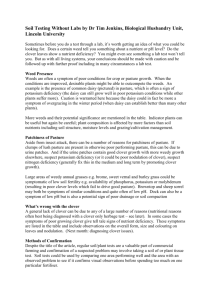Soil Conservation Measures and Guidelines
advertisement
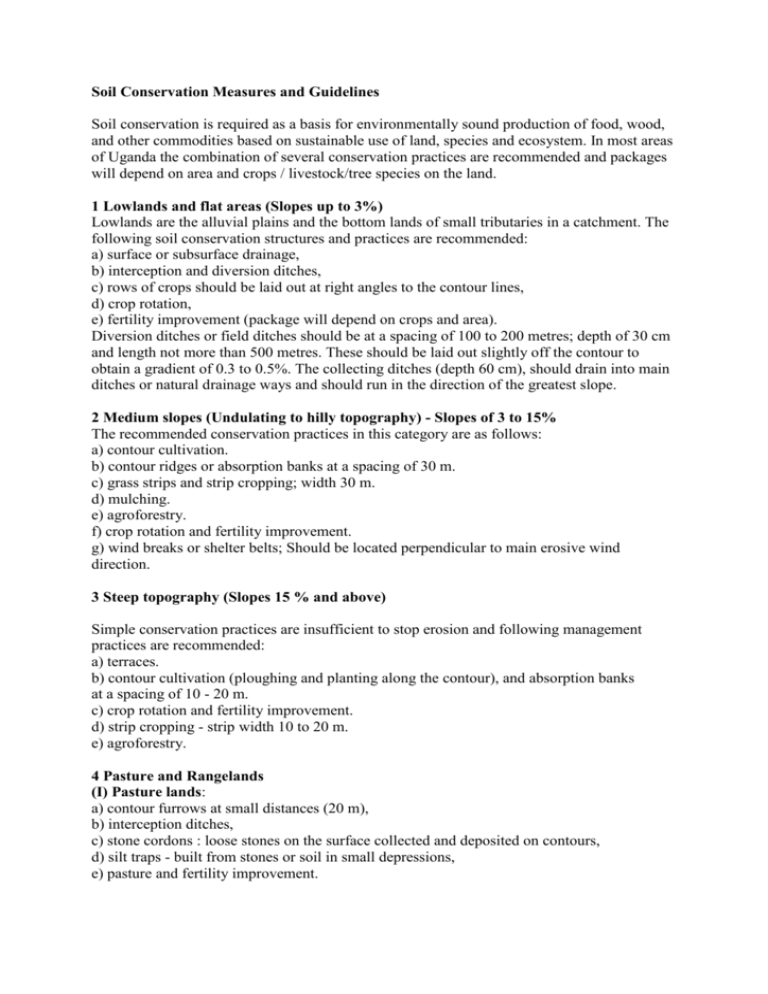
Soil Conservation Measures and Guidelines Soil conservation is required as a basis for environmentally sound production of food, wood, and other commodities based on sustainable use of land, species and ecosystem. In most areas of Uganda the combination of several conservation practices are recommended and packages will depend on area and crops / livestock/tree species on the land. 1 Lowlands and flat areas (Slopes up to 3%) Lowlands are the alluvial plains and the bottom lands of small tributaries in a catchment. The following soil conservation structures and practices are recommended: a) surface or subsurface drainage, b) interception and diversion ditches, c) rows of crops should be laid out at right angles to the contour lines, d) crop rotation, e) fertility improvement (package will depend on crops and area). Diversion ditches or field ditches should be at a spacing of 100 to 200 metres; depth of 30 cm and length not more than 500 metres. These should be laid out slightly off the contour to obtain a gradient of 0.3 to 0.5%. The collecting ditches (depth 60 cm), should drain into main ditches or natural drainage ways and should run in the direction of the greatest slope. 2 Medium slopes (Undulating to hilly topography) - Slopes of 3 to 15% The recommended conservation practices in this category are as follows: a) contour cultivation. b) contour ridges or absorption banks at a spacing of 30 m. c) grass strips and strip cropping; width 30 m. d) mulching. e) agroforestry. f) crop rotation and fertility improvement. g) wind breaks or shelter belts; Should be located perpendicular to main erosive wind direction. 3 Steep topography (Slopes 15 % and above) Simple conservation practices are insufficient to stop erosion and following management practices are recommended: a) terraces. b) contour cultivation (ploughing and planting along the contour), and absorption banks at a spacing of 10 - 20 m. c) crop rotation and fertility improvement. d) strip cropping - strip width 10 to 20 m. e) agroforestry. 4 Pasture and Rangelands (I) Pasture lands: a) contour furrows at small distances (20 m), b) interception ditches, c) stone cordons : loose stones on the surface collected and deposited on contours, d) silt traps - built from stones or soil in small depressions, e) pasture and fertility improvement. In addition, an optimum stocking rate is required. The following are the recommended stocking rates a) Areas with fertile soils and rainfall >850 mm per year = 2 cows per hectare. b) Areas with low fertility and rainfall <850 mm per year =1 cow per hectare. Pasture species and animal breeds are additional considerations which should be taken into account to finally determine the stocking rate. ii) Rangelands: The recommendations in this category apply to the " Cattle Corridor" and are dependant on state of rangelands. a) re-vegetation or reseeding - closing the area to grazing and allow natural grasses to establish or re-seed with suitable species of grasses and legumes. b) gully control with mechanical barriers (dry reeds, vegetation, stones etc.), c) controlled or rotational grazing; d) run off harvesting - divert and impound run off to prevent soil erosion , gully development and allow slow permeability into the soil. e) fertility improvement, f) remove low value grass and tree species to allow nutritive species to proliferate and cover bare ground.



